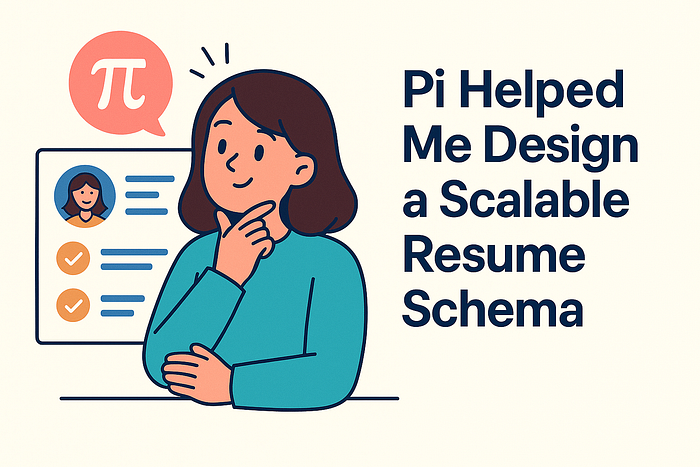Designing a resume data model sounds simple — until you need it to scale. Here's how Pi AI guided me to build something future-proof and flexible.
I thought I was just building a basic resume feature.
Something like:
- Name
- Skills
- Experience
But as the scope expanded — custom layouts, international users, multiple resumes per user — I realized my original schema wouldn't cut it.
I needed something flexible, normalized, and built for growth.
So I turned to Pi AI.
It didn't just spit out boilerplate tables. It asked thoughtful questions. And helped me rethink the structure completely.
🧠 Step 1: Start with Real-World Use Cases
My prompt to Pi:
"How should I structure a database schema for a resume builder app?"
Pi replied:
"Before designing the schema, consider: — Will users create multiple resumes? — Will you support templates and themes? — Should each section (e.g., education, work) be reusable or embedded?"
This made me rethink my assumptions.
✅ Yes, users will want multiple resumes. ✅ Yes, they'll want to reorder or hide sections. ✅ And yes, custom fields might matter for niche industries.
Time to normalize.
📐 Step 2: Modular Table Design with Relationships
With Pi's help, I designed a flexible relational schema.
Here's a simplified version:
🗃️ Core Tables
-- Users table
users (
id UUID PRIMARY KEY,
name TEXT,
email TEXT UNIQUE,
...
)
-- Resume (one user can have many)
resumes (
id UUID PRIMARY KEY,
user_id UUID REFERENCES users(id),
title TEXT,
summary TEXT,
theme TEXT,
created_at TIMESTAMP,
updated_at TIMESTAMP
)
-- Experience section
experiences (
id UUID PRIMARY KEY,
resume_id UUID REFERENCES resumes(id),
company TEXT,
role TEXT,
start_date DATE,
end_date DATE,
description TEXT,
order_index INT
)
-- Education section
education (
id UUID PRIMARY KEY,
resume_id UUID REFERENCES resumes(id),
institution TEXT,
degree TEXT,
field TEXT,
start_date DATE,
end_date DATE,
description TEXT,
order_index INT
)Pi recommended using order_index to preserve custom section order—a key UX detail I hadn't thought about.
🛠️ Step 3: Handling Dynamic Sections and Custom Fields
I asked:
"How should I store dynamic resume sections like awards, certifications, or hobbies?"
Pi suggested:
- Separate optional tables for common extras (e.g.
certifications,projects) - A generic
custom_sectionstable with atype,label, andcontentfield for custom user-defined blocks
🧱 Example:
custom_sections (
id UUID PRIMARY KEY,
resume_id UUID REFERENCES resumes(id),
type TEXT, -- e.g. "award", "language"
label TEXT,
content JSONB,
order_index INT
)The use of JSONB made it flexible while still queryable.
Perfect for storing variable content like:
{"award": "Top Developer", "year": "2023"}{"language": "German", "proficiency": "Intermediate"}
🧩 Step 4: Localized and Multi-Format Support
I asked Pi:
"What if users want different versions of the same resume — for jobs in different languages?"
Pi's advice:
- Store
languageandregionfields in theresumestable - Duplicate records for translation, instead of trying to localize sections inline
- Allow linking resumes to each other with a
variant_offield
So I added:
resumes (
id UUID PRIMARY KEY,
user_id UUID,
title TEXT,
language TEXT,
region TEXT,
variant_of UUID -- Self-referencing
)Now users can have a base resume and variants for German, UK, US job markets.
📊 Step 5: Design Decisions for Performance
Pi also helped me decide:
Feature Design Choice Section reordering order_index integer field Field flexibility Use JSONB for optional sections Text search Add tsvector for full-text Resume duplication Soft-copy via foreign key Multi-resume support One-to-many users → resumes
This kept my schema performant, but still flexible enough for different use cases.
💡 Final Schema Highlights
- 👥 Multi-resume support per user
- 🧱 Modular tables per section
- 🧠 Dynamic sections using
custom_sections+JSONB - 🌍 Localization via language + variant linking
- ✍️ Order preservation for resume UI rendering
Thanks to Pi's prompts, I felt like I was designing with a product architect, not just an AI assistant.
🙌 Takeaways
- Pi doesn't just give answers — it asks you the right questions
- It's perfect for early-stage design thinking
- I saved hours of trial-and-error by talking through my ideas with Pi
If you're building a product that involves structured content like resumes, profiles, or form builders — Pi can guide you like a smart co-architect.
💬 What About You?
🧠 Ever used AI to design a database? 📎 Share your schema questions or use cases in the comments 👏 Clap if this saved you some design time 🔗 Share this with your team or fellow devs building resume builders, HR tools, or personal sites
Thank you for being a part of the community
Before you go:
- Be sure to clap and follow the writer ️👏️️
- Follow us: X | LinkedIn | YouTube | Newsletter | Podcast | Twitch
- Start your own free AI-powered blog on Differ 🚀
- Join our content creators community on Discord 🧑🏻💻
- For more content, visit plainenglish.io + stackademic.com


